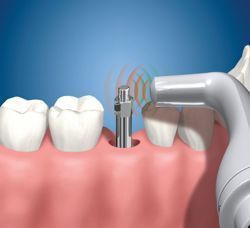Osseointegration
Osseointegration is the connection between a living bone and the surface of an artificial implant, both functional as well as structural. Typically, titanium is used because it is an effective load-bearing implant. What it effectively does is allow for a prosthetic limb to fuse to the bone. When this occurs, it is as if the person (or animal) has a new limb rather than something connecting to the old limb. Since it is using titanium, the body won’t reject it because it is not interfering with the cells. While it has only been used in small scale dental procedures, researchers have begun to create types of limbs with it.
Currently, the only successful trial of placing a titanium lower-leg implant on a patient was with a German Shepard in 2008. The limb was a success and the body did not reject it; however, researchers have yet to find a way to successfully create a limb that could work with humans. It is being suggested, though, that there is the capability of creating a limb similar to the one that Cassidy (the dog) had that will allow for the human to comfortably walk as if they had never lost their leg to begin with.
History of Osseointegration
The finding of osseointegration actually happened by accident. In 1952, Professor Per-Ingvar Branemark, a Swedish researcher, was trying to study the blood flow in a rabbit bone. He inserted a titanium implant chamber into the bone. However, what he found when he tried to remove it was that the bone had integrated with the chamber so completely that it was unable to be removed. The bone had, without rejecting the titanium, fused to it. Branemark realized that there was potential for this to benefit humans. The first big use for it was in dentistry to fixate teeth. More importantly, it has seen use for cranial reconstruction.
Uses of Osseointegration
Currently, there are three primary uses of osseointegration. The first is, simply, dental implants. To ensure that teeth stay secure, doctors use a titanium implant to fuse to the bone and hold it in place. It is effective and was what Branemark first assumed would work in humans. However, since then, it has gone on to be used for many other things. With the loss of ears, eyes and noses, scientists thought that they might able to make them stick if they used titanium. Using the titanium and osseointegration, the bone fused to the metal and therefore, the ear, eye and nose stayed in place. Finally, researchers developed a bone anchored hearing aid that wouldn’t be removed and was, using titanium and osseointegration again, fused to the inner bones of the ear to make hearing much easier for those with exceptional hearing loss.


Comments - No Responses to “Osseointegration”
Sorry but comments are closed at this time.